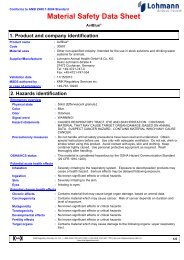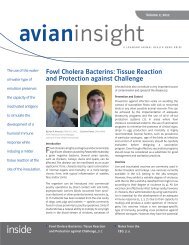You also want an ePaper? Increase the reach of your titles
YUMPU automatically turns print PDFs into web optimized ePapers that Google loves.
AvianInsight Summer Vol 3-03 3/7/05 2:26 PM Page 14 avian insightfrom the president…Fighting Avian InfluenzaIn this issue of Avian Insight, youwill find information on AvianInfluenza (AI) vaccines. We hopeyou find it interesting.LAHI has a long history and greatprofessional depth in the area of AIvaccine production. We are the onlyUS company with nine ConditionalAvian Influenza USDA Licenses.This means we have master seedsfor each strain and are ready to makevaccine for a particular type whenneeded by the industry. In addition,we are equipped to produce an autogenousAI vaccine from a field isolate.Addressing the needs of the poultryindustry in the case of an outbreak ofAI is complex. First of all, state andfederal authorities must determine thebest way to deal with the outbreak.They will determine the controlapproach best suited to the situation:quarantine and eradication, vaccinationor a combination of both. To maketheir determination, they must usemultiple professional disciplines.In the LAHI group, we have severalprofessionals who form the “AITeam” including staff members fromour veterinary, regulatory, productionand diagnostics laboratory divisions.Once an outbreak has occurred in theUS poultry industry, we alert the AIteam. They are then included in allfurther communications on this outbreak.This allows us to have, at ourdisposal, up to date information onthe disease outbreak (veterinarian),USDA and state decisions (regulatory),manufacturing (LAHI head ofproduction) and diagnostics (inhousediagnostics experts). Since AIoutbreaks are rare, it is critical thatV.3 2003affected producers and companiesare given accurate information inresponse to their inquiries. Throughthe development of our AI team,LAHI is prepared to service thepoultry industry in an efficient andknowledgeable manner when AIvaccines are needed.If you are involved in an AI outbreak,we hope you will turn to us when thedecision to vaccinate has been made.ErratumIn the previous edition of Avian Insight,a typographical error occurred in Dr.Peter Holt’s article. In the Materials andMethods section, experiment 2, sentencebeginning with “For any samples withno growth…”, the units on that volumeshould be in microliters. We apologize forany confusion this error may have caused.Gainesville, GA 305011146 Airport Parkwayavian insightA LOHMANN ANIMAL HEALTH NEWS BRIEF V.3 2003Evaluation of a commercial avian influenza (H7N2) vaccinefor protection in turkeys against an avian influenza virus(H7N2) isolated from turkeys in Virginia during 2002Terrence M. Tumpey, Darrell R. Kapczynski and David E. SwayneSoutheast Poultry Research Laboratory, United States Department of Agriculture, Athens, GA 30605INTRODUCTIONAvian influenza (AI) is a disease ofpoultry that has occurred worldwideover the past 100 years. AI is causedby type A Orthomyxoviruses ofwhich there are 15 hemagglutinin(H1-H15) and nine neuraminidase(N1-N9) subtypes. Each AI virus isdesignated by the specific subtype, forexample H5N9. Although chickensand turkeys are not natural hostspecies for AI, the viruses can routinelycrossover from the wild-bird reservoirto poultry. It is thought that thesetransmissions are the result of wildbirds shedding large amounts ofinfectious virus into the environment.For example, water contaminatedIn this issue of avian insight:Terrence M.Tumpey,SoutheastPoultry ResearchLaboratory,United StatesDepartment ofAgriculture,Athens, GAEvaluation of a commercialavian influenza (H7N2) vaccinefor protection in turkeys againstan avian influenza virus .......p.1The following is a written summary of Dr. Tumpey’s presentation fromthe 52nd Western Poultry Diseases Conference, Sacramento, CA entitled“Protective efficacy of an inactivated Avian Influenza vaccine againstchallenge with a 2002 H7N2 Avian Influenza virus.”with AI virus from the feces ofinfected wild birds has been a sourceof infection for domestic turkeys inthe U.S.When AI infects poultry, the virus isexcreted from both the respiratoryand the digestive tracts. Thereforebird-to-bird transmission is veryefficient via aerosol and contaminatedfeces and droppings or various fomites.It can cause a wide range of diseasesymptoms of which there are twomain pathotypes. Highly pathogenic(HP) AI causes an extremely infectious,multi-organ systemic disease, resultingin high mortality and hemorrhagicor inflammatory lesions. It has beenestimated that the next outbreak ofa HPAI virus, similar to the 1983outbreak in Pennsylvania, will havean economic impact of over $150million to the U.S poultry industry.AI associated with mild respiratorydisease, reductions in egg productionand moderate increases in mortalityare considered low pathogenic (LP).Surveillance of poultry has resulted indetection of LPAI virus by isolationor serology among commercial poultryin sixteen states from 1992 through1998. Major outbreaks involvingmore than one million turkeysoccurred in Minnesota during 1991through 1995 and in Utah during1995. In 2000, H6N2 LPAI outbreakamong layer chickens occurred inCalifornia resulting in a drop in eggproduction and mild respiratory diseasein the uncomplicated form. Also,significant morbidity and mortalitywas attributed to secondary infections.Many other subtypes of AI have beenrecovered from poultry and othergallinaceous birds in the last 3 yearsincluding H1N2, H5N2, H3N8,H3N4, H6N1, H6N8, and H9N4.Thus, the poultry industry is constantlyfaced with the potential threat of AIvirus infections which can result insubstantial economic losses.More recently, a LPAI virus,type H7N2, was isolated in theShenandoah Valley of Virginiaand portions of North Carolina,avian insight For further information: 770.532.3627 • 800.655.1342 • www.lahinternational.comFrom the president ...............p.4continued on page 2
AvianInsight Summer Vol 3-03 3/7/05 2:26 PM Page 22 avian insight V.3 20033 avian insight V.3 2003continued from page 1 continued from page 2Pennsylvania and West Virginia. This outbreak startedin and was largely confined to turkey breeder flocks andmeat-type birds; however the broiler and broiler-breederindustries have also been impacted. Before the last positivefarm was detected in July of 2002, Virginia’s StateVeterinarian quarantined 197 Shenandoah Valley poultryfarms and ordered the depopulation of 4.7 millionturkeys and chickens. The outbreak is estimated to havecost the poultry industry approximately $130 million.When flock outbreaks of AI occur, the implementationof control measures and eradication or “stamping-out”policies usually becomes the goal, however vaccinationmay also be considered as part of the intervention strategy.For example, AI inactivated vaccines were used as partof a control program against sporadic outbreaks of LPAIin Minnesota and Utah. One vaccine strategy in the U.S.for AI includes the use of killed antigen preparations toimmunize flocks. These vaccines are full or conditionallylicensed for parenteral (subcutaneous or intramuscular)administration and have been successful at providingprotection against clinical signs and death. However,controlling AI through vaccination presents a challengedue to continual antigenic changes of viral surfaceglycoproteins, hemagglutinin (HA) and to a lesserextent neuraminidase (NA). Effective influenza vaccinesare largely based on the induction of strain-specificimmunoglobulin G (IgG) neutralizing antibodies directedagainst the HA, which can persist for extended periodsin the host. Antibodies to the second major viral surfaceprotein, NA also contributes to recovery from infection.Immunity induced by influenza vaccines provides optimalprotection against viruses that are antigenically closelymatched with those in the vaccine, but are less effectiveagainst antigenic variants within a subtype and provideslittle, if any, resistance to infection with a differentAI virus. Therefore, determination of antigenicrelatedness between AI isolates and vaccine efficacyagainst antigenic variants will provide valuableinformation to the poultry industry.The outbreak of H7N2 LPAI in Virginia this past yearraised serious questions about the availability of vaccinesto provide protection against disease in poultry. A studywas undertaken by the U.S. Department of Agricultureat Southeast Poultry Research Laboratory to determineif an existing commercial H7N2 AI vaccinemanufactured by <strong>Lohmann</strong> <strong>Animal</strong> <strong>Health</strong> could provideprotection against a recent H7N2 2002 isolate.MATERIALS AND METHODSThe commercial AI vaccine was prepared by <strong>Lohmann</strong><strong>Animal</strong> <strong>Health</strong>. The seed stock, A/Chicken/Pennsylvania/21342/97 (CP/97, H7N2) virus had previousapproval by the U.S. Department of Agriculture as anH7 subtype vaccine. The vaccine virus was propagatedin embryonated chicken eggs, inactivated with formalin,and emulsified in a proprietary oil-based vaccine. Theefficacy of this vaccine was tested in two different agegroups of turkeys obtained from the British UnitedTurkeys of America (Lewisburg, WV). Groups of eight1-day-old and 4-week-old turkeys were immunized withthe commercial inactivated vaccine either once or twice.Control turkeys received the same volume of normalallantoic fluid emulsified in the same adjuvant and areidentified as sham-vaccinated. Turkeys were vaccinatedby subcutaneous inoculation of 0.5 ml vaccine in thenape of the neck. Boosted turkeys received a secondinoculation 14 days after initial vaccination. Serum wascollected from each bird 14 and 28 days after initialinoculation. Hemagglutination-inhibition (HI) assayswere performed in 96-well microtiter plates with 0.5%chicken erythrocytes by standard methods. At 29 daysafter initial vaccination, turkeys were challengedintranasally with 10 7.0 EID 50 of A/Turkey/Virginia/15851/02 (TV/02) in a volume of 100 µl. An additionalgroup of eight 4-week-old control White PlymouthRock (WPR) chickens (Southeast Poultry ResearchLaboratory [SEPRL], Athens, GA) were infectedsimilarly for comparison. Following infection, chickensand turkeys were monitored daily for disease signs for14 days post-infection. For determination of virusshedding, oropharyngeal and cloacal swabs were takenfrom 8 birds on days 1-5, 7, 10 and 13 post-infection.Virus isolation and titrations were performed in10-day-old embryonated chicken eggs and fifty percentegg infectious dose (EID 50 ) titers were determined bystandard methods.RESULTS AND CONCLUSIONBecause LPAI H7N2 was detected mostly in turkeyflocks, with only a few chicken flocks affected, we firstcompared susceptibility of the two species to H7N2virus infection. Figure 1 illustrates the mean virus titersrecovered from the oropharynx of A/Turkey/Virginia/158512/02 (TV/02) virus-infected chickens and turkeysfollowing an intranasal inoculation with 10 7 EID 50 ofTV/02 virus. The limit of virus detection was 10 1.2EID 50 /ml. In general, TV/02 virus was recovered fromthe oropharynx of both species during the first week ofinfection. The level of infectious virus recovered fromturkeys was 20 to 158 fold higher than what was detectedin the oropharynx of chickens. Further experimentationcompared the fifty percent bird infectious dose (BID 50 )in chickens and turkeys by determining the infectiousvirus titers in the oropharynx at 3 days post-inoculation.It was determined that 100 to 200 times more TV/02virus was required to infect chickens versus turkeys.In the vaccine trial, neither sham-vaccinated nor H7N2-vaccinated turkeys developed clinical signs or deathfollowing challenge with 10 7 EID 50 of TV/02 virus.However, high titers of challenge virus could be detectedfrom swabs collected from the oropharynx on days 1-7after challenge in the sham-vaccinated group (Figure 2).Low or undetectable viral titers were recovered fromcorresponding cloacal samples from control turkeys orchickens (not shown), indicating that this LPAI virusreplicates more efficiently in the respiratory tract versusthe gastrointestinal tract. Figure 2 illustrates that vaccinated(1x and 2x vaccinated) turkeys had a significantreduction in titers of challenge virus shed from theoropharynx in comparison to the sham-vaccinatedgroups for days 1-5 after challenge. Furthermore, viralshed in vaccinated birds decreased such that only oneturkey of 16 was positive for AI virus in the oropharynx,whereas all 8 sham-vaccinated controls still had highviral titers at day 5 post-challenge. A vaccine boostFigure 1. Oropharyngeal Virus Recoverylog 10 EID 50 /ml64208-wk-old turkeys4-wk old turkeys4-wk old chickens0 1 2 3 4 5 7 10 13Days after infectionenhanced the protection from infection as the mean virustiters for days 1-3 after challenge were reduced by 5 to 8fold in comparison to turkeys that received a single vaccine.Sera were collected from eight turkeys per groupand tested for the presence of HI antibody titers againstthe homologous vaccine virus as well as the 2002 H7N2virus. HI antibody titers induced by either H7N2 viruswere similar as one dose of vaccine induced an HIresponse of 32 and administration of a second dose ofvaccine resulted in an elevated HI antibody of 64.Figure 2. Vaccine Efficacylog 10 EID 50 /ml6420Sham 8-wk-oldH7N2 vaccine 1XH7N2 vaccine 2X0 1 2 3 4 5 7 10 13Days after infectionOnce an AI outbreak begins there is insufficient time toprepare a new AI vaccine to control the initial spread ofvirus. Information regarding the vaccine efficacy of anexisting commercial vaccine provides affected states andpoultry industries with valuable information when consideringvaccination as part of the control or eradicationprogram. This study demonstrated that an AI vaccineprepared from a 1997 seed stock (A/Chicken/Pennsylvania/21342/97) virus provided protectionagainst a recent 2002 AI virus isolated from a turkey inVirginia. The CP/97 vaccine significantly reduced boththe number of turkeys shedding the challenge virus andtiters shed from vaccinated turkeys as compared to shamvaccinates. The HA protein of the recent 2002 H7N2Virginia isolate shares a 97% protein sequence identitywith the CP/97 vaccine. It has been demonstrated thatin poultry the challenge viruses can have as little as85% HA protein sequence similarity with the vaccinestrain and still provide vaccine protection. This broadbasedprotection against AI isolates observed in poultryprovides opportunities to use existing vaccines even inthe face of antigenic drift in seasonal field AI viruses.continued on page 3
















